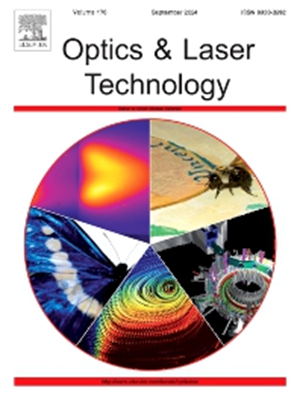通过线性腔干涉 NPE 在全调频掺铥光纤激光器中产生谐波锁模脉冲和类噪声脉冲
IF 4.6
2区 物理与天体物理
Q1 OPTICS
引用次数: 0
摘要
这项研究展示了在通过线性腔干涉非线性偏振演化(NPE)机制锁模的全偏振保持(PM)掺掺锑光纤激光器中产生谐波锁模(HML)和类噪声脉冲(NLP)的过程。调整泵浦功率和操纵沿 PM 光纤轴向的腔内脉冲分布可实现基本锁模、各种谐波阶次和 NLP 之间的转换。在 HML 状态下,实现了 19 阶谐波孤子脉冲,这标志着基于 NPE 的全 PM 线性腔光纤激光器的重复率达到了破纪录的 ∼229 MHz。报告详细分析了不同谐波阶次的脉冲特性,其中三阶 HML 表现出较高的超模抑制水平。通过噪声评估以及功率和频谱的长期评估,进一步证实了三阶 HML 运行的稳定性。在 NLPs 状态下,输出以 1962 nm 为中心,3-dB 带宽为 ∼30 nm,平均功率为 284 mW,脉冲能量为 ∼24 nJ。对激光器的长期稳定性和噪声曲线进行了研究,以确保 NLPs 的持续运行。此外,还研究了泵浦功率变化对 NLP 光学特性的影响,发现泵浦强度越高,光谱宽度越大,光谱越红移,相干峰持续时间越短。本文章由计算机程序翻译,如有差异,请以英文原文为准。
Generation of harmonic mode-locked pulses and noise-like pulses in an all-PM Tm-doped fiber laser via linear-cavity interferometric NPE
This study demonstrates the generation of both harmonic mode-locking (HML) and noise-like pulses (NLPs) in an all-polarization-maintaining (PM) Tm-doped fiber laser mode-locked by a linear-cavity interferometric nonlinear polarization evolution (NPE) mechanism. Adjusting the pump power and manipulating the intra-cavity pulse distribution along the axes of the PM fiber enable transitions between fundamental mode-locking, various harmonic orders, and NLPs. In the HML regime, a 19th-order harmonic soliton pulse is achieved, marking a record-breaking repetition rate of ∼229 MHz for NPE-based all-PM linear-cavity fiber lasers. Detailed analyses of pulse characteristics across different harmonic orders are presented, with the 3rd-order HML exhibiting a high supermode suppression level. The stability of 3rd-order HML operation is further confirmed through noise evaluations and long-term assessments of power and spectrum. In the NLPs regime, the output is centered at 1962 nm with a 3-dB bandwidth of ∼30 nm, achieving an average power of 284 mW and a pulse energy of ∼24 nJ. The long-term stability and noise profile of the laser are examined to ensure sustained NLPs operation. Furthermore, the influence of pump power variations on the optical properties of NLPs is investigated, revealing an increased spectral width, red-shifted spectrum, and reduced duration of coherent peaks with higher pump intensities.
求助全文
通过发布文献求助,成功后即可免费获取论文全文。
去求助
来源期刊
CiteScore
8.50
自引率
10.00%
发文量
1060
审稿时长
3.4 months
期刊介绍:
Optics & Laser Technology aims to provide a vehicle for the publication of a broad range of high quality research and review papers in those fields of scientific and engineering research appertaining to the development and application of the technology of optics and lasers. Papers describing original work in these areas are submitted to rigorous refereeing prior to acceptance for publication.
The scope of Optics & Laser Technology encompasses, but is not restricted to, the following areas:
•development in all types of lasers
•developments in optoelectronic devices and photonics
•developments in new photonics and optical concepts
•developments in conventional optics, optical instruments and components
•techniques of optical metrology, including interferometry and optical fibre sensors
•LIDAR and other non-contact optical measurement techniques, including optical methods in heat and fluid flow
•applications of lasers to materials processing, optical NDT display (including holography) and optical communication
•research and development in the field of laser safety including studies of hazards resulting from the applications of lasers (laser safety, hazards of laser fume)
•developments in optical computing and optical information processing
•developments in new optical materials
•developments in new optical characterization methods and techniques
•developments in quantum optics
•developments in light assisted micro and nanofabrication methods and techniques
•developments in nanophotonics and biophotonics
•developments in imaging processing and systems

 求助内容:
求助内容: 应助结果提醒方式:
应助结果提醒方式:


